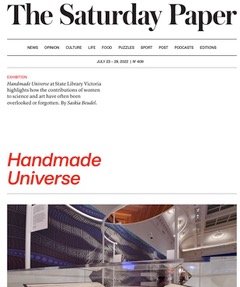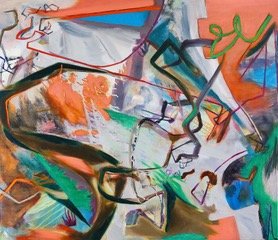A great pleasure to write a catalogue essay for Bianca Hester’s Lithic Bodies exhibition. Curated by Bronwyn Bailey-Charteris. UNSW Galleries, 27 Sept – 24 Nov 2024

A great pleasure to write a catalogue essay for Bianca Hester’s Lithic Bodies exhibition. Curated by Bronwyn Bailey-Charteris. UNSW Galleries, 27 Sept – 24 Nov 2024
The unflinching gaze of Nan Goldin, ABR Arts
‘“It’s as if my hand were a camera,” Nan Goldin wrote in 1986, as much a part of her everyday life as talking, eating or sex. Her camera was just as commonplace, at that time, in her friends’ lives, capturing them naked or semi-clothed in bed, eyes closed in the shower, sprawled on towels at the beach, or masturbating. Historical markers abound: a red telephone with spiral cord, cassette players, a cheeseburger radio, Playboy magazines, a Kathy Acker book on a beach towel, Cyndi Lauper on a dim blue TV screen.’ ABR Arts

My review of SYNERGY: Tony Tuckson – drawing into painting published in ABR Arts
In one of my favourite series, the drawings take on the pared-back simplicity and radiance of the late paintings. A handful of wavering vertical strokes of charcoal inscribe pieces of thick paper torn into irregular shapes, some almost vase-like (Untitled, undated [TD 6628]). It’s easy to imagine that these paper shapes are informed by the bark paintings Tuckson was so familiar with as a curator. Like the barks, they are roughly rectangular but organically skewed. Untitled, c.1970–1973 is a tall piece almost the dimensions of a standing human figure. Here, the charcoal marks are more cumulative and insistent, sweeping the length of the faintly discoloured paper like a life force. This sense of vitality, energy, and urgency permeates the entire exhibition.

Thrilled to receive a copy of Fieldwork for Future Ecologies, edited by artists Bridget Crone, Sam Nightingale and Polly Stanton. My essay ‘Fieldwork: Collapsing Landscapes’ included among a rich collection of contributions.
The editors write: ‘Our project emerges from a series of continuing and evolving conversations between artists, writers and researchers based in Australia, the US, UK and Europe who illuminate the vastly different approaches they take to field working and the myriad ways it informs and enfolds their practices.’ Published by Onomatopee in the Netherlands.

My scholarly article ‘The “living humanities”’ has been so long in the making – lots of archival research. Just published in TEXT 26 (2), October 2022.

I couldn’t be more grateful to receive a Fellowship for Non-Fiction Writing from the Copyright Agency. These generous fellowships support Australian authors to write new work. I’ll be completing my fourth book, Peaking: High Intensity Training at the End of the World – on cycling, landscapes, the ageing process, an experimental memoir.

‘Walking: West MacDonnell Ranges’, HEAT archive
First published in HEAT magazine in 2005, then republished in Best Australian Essays 2006. Thanks to editor Alexandra Christie for its reappearance.

One of the most poignant aspects of Handmade Universe is how it foregrounds seemingly humble objects and casts them in new light, retrieving not only forgotten handiwork but also achievements from the past.
Handmade Universe: From craft to code and spaces between is showing at the State Library of Victoria until February 2023.

With its breadth and depth of ecological knowledge, enlivened by personal observation, Australian Deserts surely belongs among classics such as H H Finlayson’s The Red Centre.
– Australian Book Review May 2022

Catalogue essay for David Palliser’s exhibition Subjects in Orbit, Jacob Hoerner Galleries, Melbourne.
14 July–7 August 2021

David Palliser, Arrow in Japan, 2020.
Amanda Laugesen, director of the Australian National Dictionary Centre (ANU) writes of collecting words for The Australian National Dictionary: ‘I have found that the books I read and the quotations I collect are increasingly speaking not only to the climate crisis but also to climate grief.’ Among her recent reading was Living with the Anthropocene, which she describes as a ‘powerful collection’ that ‘threw up a number of quotations that might add to AND’s story about our changing environment’.
One of these, taken from Saskia Beudel’s contribution, is for the term greenie, an Australianism applied to, in the words of the dictionary, “any of a number of several predominantly green birds or animals”. She conveys a haunting sense of loss: “Most unnerving is the absence of small native birds once common here: the silvereyes and small honeyeaters called greenies.”
– Amanda Laugeson, ‘“The awful sense of loss”: The language of climate grief’, Australian Book Review, May 2021
Mehwish Iqbal, Assemblage of a Fragmented Landscape (detail, installation view) 2020, Museum of Contemporary Art Australia. Photograph: S Beudel
Read MoreAt the Site & Sound exhibition held at McClelland Sculpture Park + Gallery, something of the world itself – water flowing through landscapes, katabatic winds in the Antarctic, an empty glass bottle rolling along a pavement, human voices in the wake of a tsunami, a clicking dawn chorus of shrimps – is transmitted via its sonic residues.
Review-essay published online in Artlink and in print Artlink April 2021
‘What surprises me most when I look back on this period of employment is how much I internalised structural inequities as my own deficiency.’ Published in Kill Your Darlings

Image: Andrew Mason, Flickr (CC BY-2.0)
The narratives that inform and, indeed, are inseparable from these works are shocking. They are still fresh, travelling down generations, the artists attuned. These are living histories, urgent and raw, tangible in the present – probing for response from sufferers and audience alike. The Great Australian Dream is not what it seems, Hetti Perkins writes. ‘It is, in reality, a nightmare, a shimmering mirage, a candle in the coming storm.’

40 pairs of blackfellows ears lawn hill station, Judy Watson, 2008 (TarraWarra Museum of Art)
John Blay’s Wild Nature belongs to a long tradition of walking with intent. ‘Suddenly it comes clear,’ he writes. ‘We can map whatever we find and tell the story of the great escarpment forests.’ As he penned his foreword these forests went up in flames of the 2019–2020 bushfires.
Jeff Sparrow reviews Living with the Anthropocene in The Saturday Paper
‘Why do the old Romantic tropes still possess such force? In her contribution to the book, Saskia Beudel quotes Daly Pulkara, an Aboriginal man from the Northern Territory. Pulkara calls land denuded by agriculture “wild”, unlike the “quiet country” still maintained by its traditional owners. That usage – so at odds with the European focus on “wilderness” – reminds us that, prior to white settlement, Indigenous people deliberately reshaped the continent. The pre-colonial landscape reflected a purposeful interaction between humanity and nature. Capitalism destroys that transparent relationship, with the Industrial Revolution separating the population from the commons and establishing an alienation that culminates in our current situation.’
‘From James Bradley on cuttlefish to Saskia Beudel on the changing soundscape of her mother’s garden, the quality of writing in these pieces, their delight in nature and their determination not to give in to despair make for stirring reading despite the grim truths they confront.’
– Fiona Capp, ‘Non-fiction reviews: grim climate truths and a moving memoir’ Sydney Morning Herald
My cover article on Melbourne painter Prudence Flint is now out in Artist Profile magazine. Flint is represented by mother’s tankstation limited in Dublin and London, and Bett Gallery in Hobart. Her current exhibition ‘The Wish’ is at Fine Arts, Sydney 13 May – 20 June 2020.
